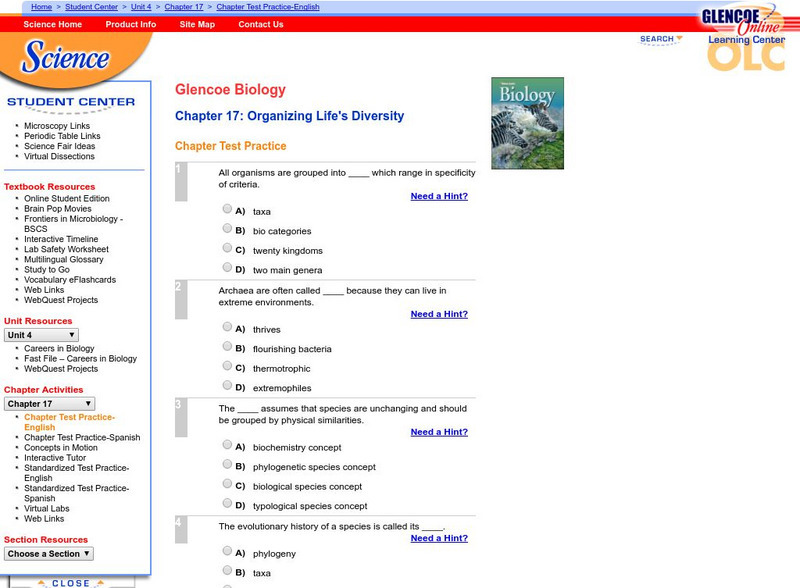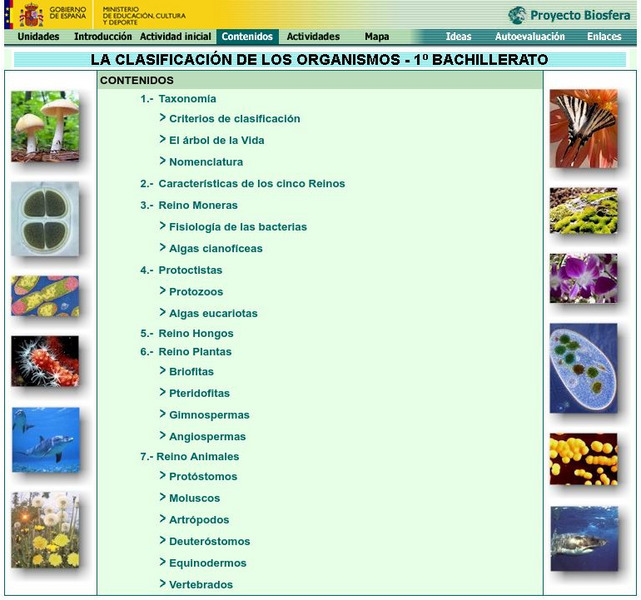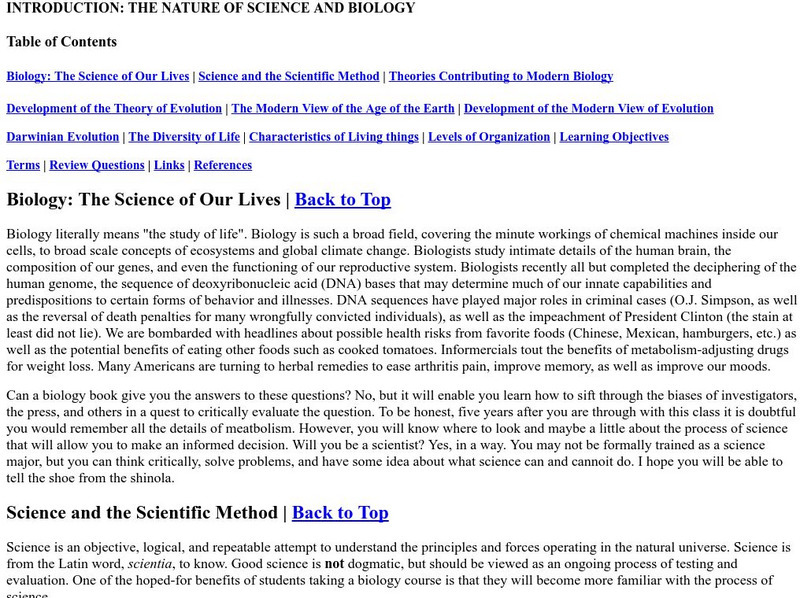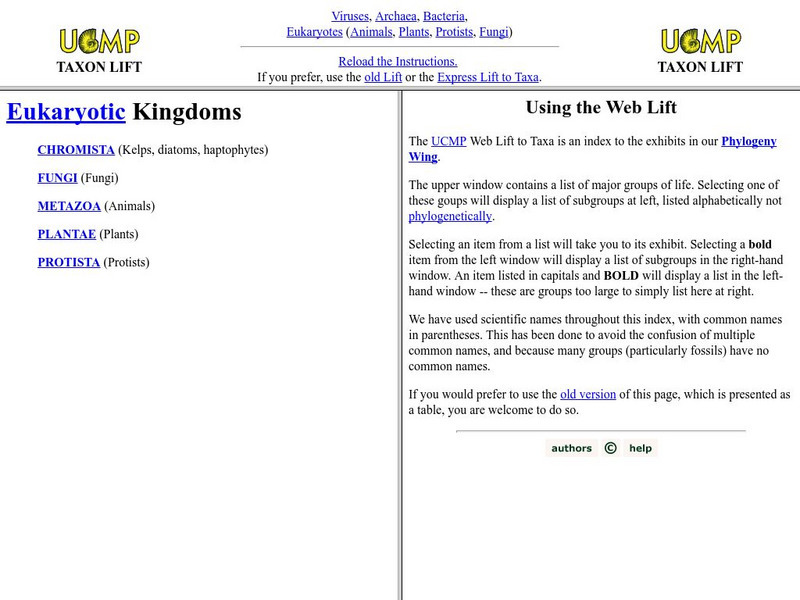Soft Schools
Soft Schools: Classification of Organisms Quiz
Take an interactive quiz over the classification of living things. After completing the quiz, check your score, and then revisit any incorrect question for further review.
Other
Secondary Science Program: The Six Kingdoms
A short overview of the six kingdoms in our scientific classification system: Plants, Animals, Protists, Fungi, Archaebacteria, and Eubacteria.
McGraw Hill
Glencoe Biology: Organizing Life's Diversity: Chapter Test Practice
A fifteen question chapter review covering concepts of the classification of life.
Other
Math and Science Activity Center: Classification of Living Things
Kingdom is the highest rank used in the biological taxonomy of all organisms. There are 6 kingdoms in taxonomy. Every living thing comes under one of these 6 kingdoms. The six kingdoms are Eubacteria, Archae, Protista, Fungi, Plantae,...
BiologyWise
Biology Wise: The 5 Significant Kingdoms of Living Things
Describes the characteristics of the five kingdoms of living things - Monera, Protista, Fungi, Plantae, and Animalia.
Other
The Domains and Kingdoms of Life
This site is a description of the history behind the 5 Kingdom system suggested by Robert Whittaker. An extensive list of resources is included.
Mocomi & Anibrain Digital Technologies
Mocomi: Classification of Plants
Discover how plants are classified and the main groups. Find out the difference between monocot and dicot plants with examples.
Other
Kids' Cruz: Taxonomy
Kidzcruz.com provides a list of phylums in the animal Kingdom. Both Latin and English names are included.
Other
Alternative Classifications of Life
The Linnaean system (1758) classified all macroscopic living organisms as either Animals or Plants, based on whether they moved [anima, with a soul] or not. Thus, Fungi were included as plants. With the invention of the microscope and...
Wikimedia
Wikipedia: Binomial Nomenclature
Wikipedia, an open-source encyclopedia, offers great information on the classification system used in Biology. Covers the benefits of the system, history, and general information on the whole system together.
National Institute of Educational Technologies and Teacher Training (Spain)
Ministerio De Educacion: La Clasificacion De Los Organismo
This unit will describe the five kingdoms and their main characteristics. It includes 20 interactive activities.
Estrella Mountain Community College
Online Biology Book: The Nature of Science and Biology
Use the scientific reasoning and critical thinking to take an in-depth look at the basics of biology.
Curated OER
Secondary Science Program: The Six Kingdoms
A short overview of the six kingdoms in our scientific classification system: Plants, Animals, Protists, Fungi, Archaebacteria, and Eubacteria. A good explanation of how organisms are placed in their particular kingdom.
Curated OER
Secondary Science Program: The Six Kingdoms
A short overview of the six kingdoms in our scientific classification system: Plants, Animals, Protists, Fungi, Archaebacteria, and Eubacteria. A good explanation of how organisms are placed in their particular kingdom.
Curated OER
Secondary Science Program: The Six Kingdoms
A short overview of the six kingdoms in our scientific classification system: Plants, Animals, Protists, Fungi, Archaebacteria, and Eubacteria. A good explanation of how organisms are placed in their particular kingdom.
Curated OER
Secondary Science Program: The Six Kingdoms
A short overview of the six kingdoms in our scientific classification system: Plants, Animals, Protists, Fungi, Archaebacteria, and Eubacteria. A good explanation of how organisms are placed in their particular kingdom.
University of California
Ucmp: Web Lift to Taxa
Alphabetical listing from the University of California of info on each of the animal phyla. Includes scientific and common names and photos. Characteristics of each group are explained in detail.
Colorado State University
Colorado State University Libraries: Garst [Wildlife] Photographic Collection
Digitized collection, searchable by name, endangered species status, habitat, or continent, of over thirteen hundred wildlife photographs taken throughout the world during the filming of Mutual of Omaha's Wild Kingdom television series....
Alabama Learning Exchange
Alex: Botany Scavenger Hunt Where's the Ginkgo?
Students use a science nature journal to log in plants native to Alabama. They sketch pictures of leaves, identify the special characteristics of the plant, and describe the environment where it was found. They also research special...
University of Guelph
Introduction to Invertebrate Biodiversity: Fungi
Find out more about fungi when you check out this comprehensive site. This resource provides an introduction and information on morphology, reproduction and the importance of fungi. Don't miss out on this fascinating source.










![Colorado State University Libraries: Garst [Wildlife] Photographic Collection Website Colorado State University Libraries: Garst [Wildlife] Photographic Collection Website](https://content.lessonplanet.com/knovation/original/209361-4b7da185aee2c7b0cebc49579baf904c.jpg?1661495039)


